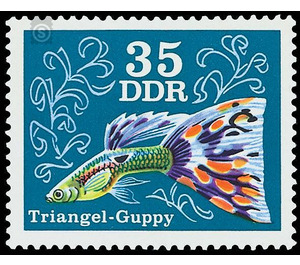Ornamental fish: guppies (Poecilia reticulata) - Germany / German Democratic Republic 1976 - 35 Pfennig
Theme: Animals
| Country | Germany / German Democratic Republic |
| Issue Date | 1976 |
| Face Value | 35.00 |
| Color | green blue |
| Perforation | K 13 1/2: 13 |
| Printing Type | offset |
| Stamp Type | Postage stamp |
| Item Type | Stamp |
| Chronological Issue Number | 1922 |
| Chronological Chapter | GER-DDR |
| SID | 465712 |
| In 20 Wishlists | |
Ornamental fish - guppies The Ministry of Posts and Telecommunications of the German Democratic Republic publishes six multicolored special postage stamps with the image of ornamental fish. Guppy Breeding in the GDR The guppy is one of the most popular ornamental fish internationally. Its scientific name is Poecilia (Lebistes) reticulata Peters 1859. This scientific name derives from the first original description of the fish by Wilhelm C. H. Peters (1815-1883). In the following years, this fish was assigned to different genera. Thus, for example, the addition (Lebistes) results from the fact that he was assigned to the genus Lebistes for a very long time (1913 to 1963) and this term is still used today in the specialist literature. The popular name "guppy" originated in 1866, when a major 19th century ichthyologist named Günther received several specimens of this fish in the British Museum in London. They came from the island of Trinidad and the sender was Jahn Lechmere Guppy, a geologist and plant collector. Since the wild guppy in the various occurrence areas (South and Central America) occurs in many different species, Günther did not consider the animals identical to the Poecilia reticulata and named it therefore in honor of the collector from Trinidad "Girardinus guppii Günther 1866". As a "guppy" then this little fish became known in the world. The scientists refer to Guayana, northern Brazil, Venezuela, Trinidad, Barbados and other Lesser Antilles as the original area of occurrence. The guppy belongs to the family of the "live-bearing tooth carps". The hallmark of the "live-bearing tooth carp" is the Gonopodium or copulation organ. This copulatory organ develops from the rays of the anal fin and is movable forward. During pre-swinging, the gonopodium forms an open channel at the top, which allows the catenary of the sperm into the urogenital papilla of the female. The fertilization of the eggs takes place in the body of the female. Shortly before birth, the egg shell bursts and the fully developed juvenile fish are born. The gestation period is exactly four weeks. The guppy as aquarium fish is easy to breed. Due to the fast generation sequence, it is possible to achieve good breeding results in a relatively short time while observing the principles of genetics. Already in its natural populations, the male guppy is very variably colored and drawn. Through domestication, new colors and shapes have been bred far beyond the original variability. Guppy breeders all over the world are guided by desirable ideals, which mainly comprise three large groups. These are short tails, sword types and large-finned forms. In many countries, guppy breeders have organized and run national and international competitions. To enable the evaluation at exhibitions, standard forms are used. Ten standards have been set by the "Guppy Breeding" Association of the German Democratic Republic for the Guppy evaluation on exhibitions in the GDR: Round tail Spitzschwanz Spatenschwanz Upper sword Second sword new forms are evaluated in special groups with predicates. The evaluation of the guppy squirrels in the standard forms is based on a 100-point system. 35 Pfennig Value: Triangle Guppy The caudal fin has the shape of a triangle with a close-fitting angle of 70 degrees. The dorsal fin is wide.


